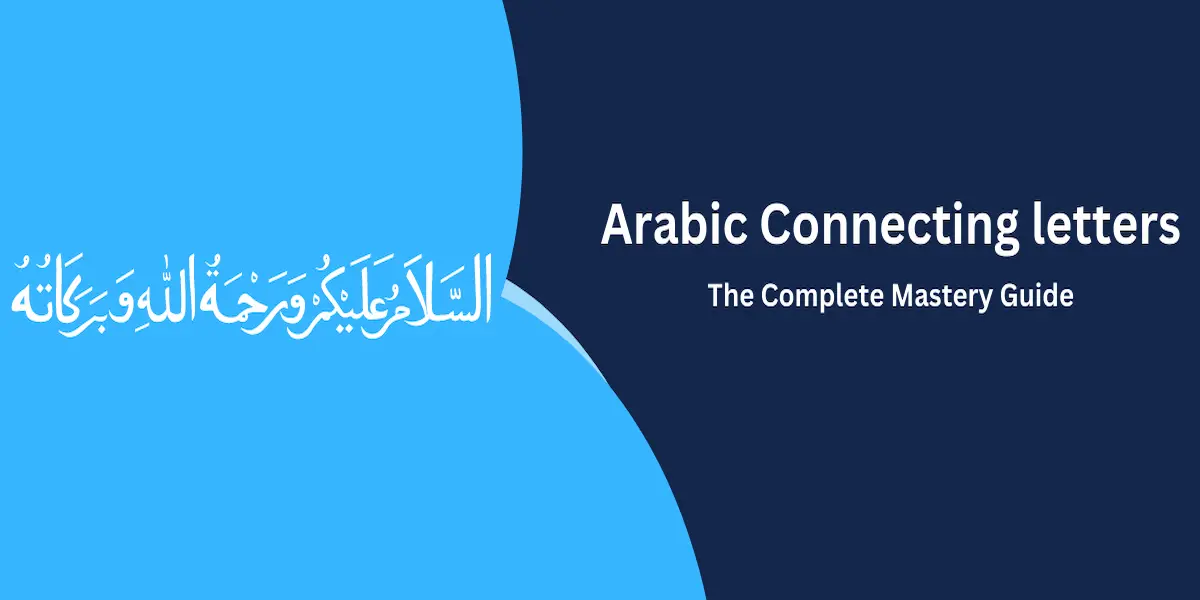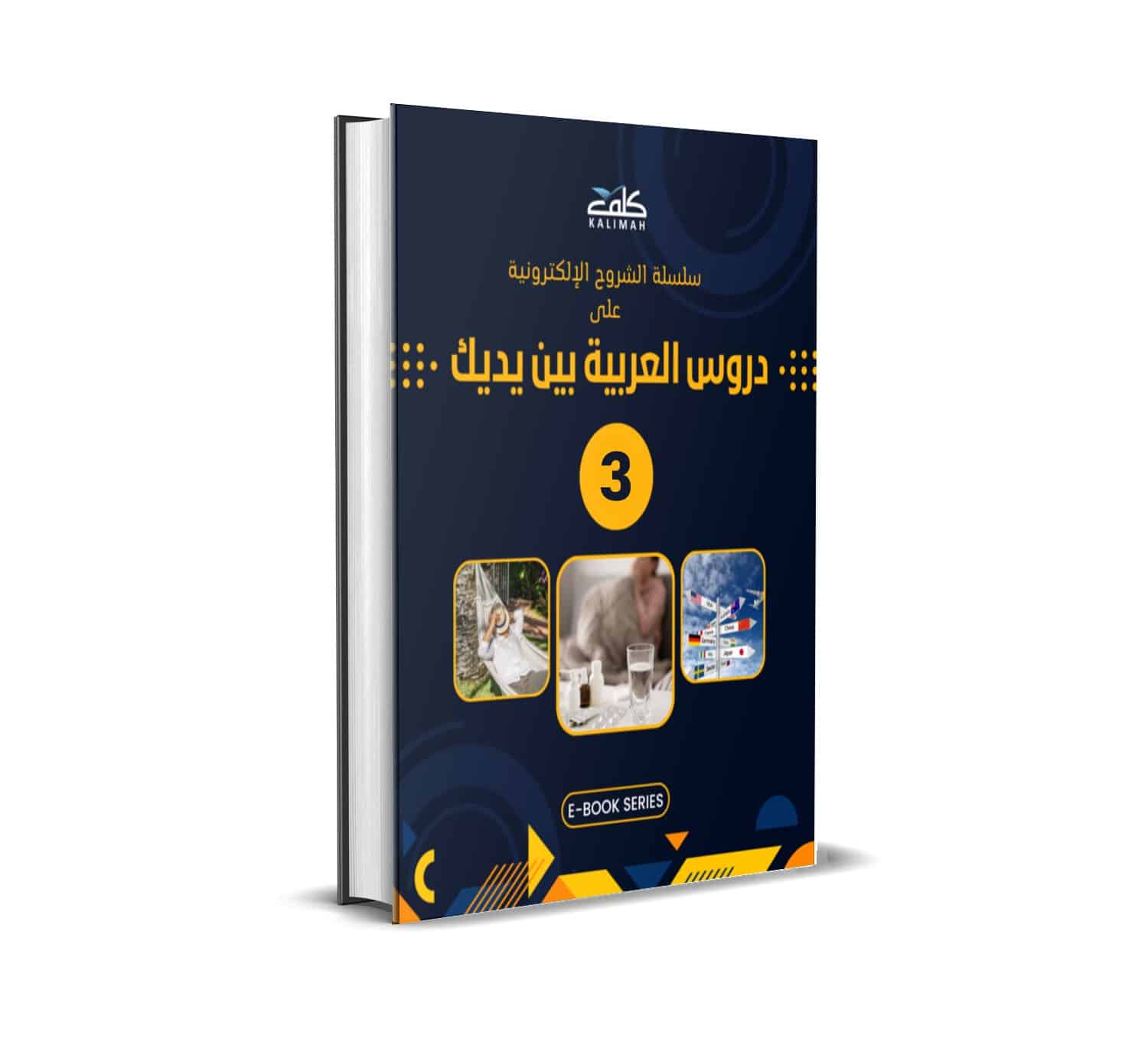In a nutshell: Arabic letters dance together in unique ways, shifting shapes based on their position in a word. Mastering these connections is key to fluent reading and writing, turning separate symbols into a smooth, flowing script that reveals the beauty and complexity of the Arabic language.
Marhaban (Welcome) everybody! Today’s lesson is about connecting letters in Arabic. This is very important to know, because it changes how some letters look when you write them. Don’t worry, we will go through it together, and you will get it!
The Arabic alphabet consists of twenty-eight letters divided into two parts from the writing perspective, Connecting Letters and non-connecting letters.
In this article, we will differentiate between them. It is worth mentioning that, we are not discussing the phonetics of the Arabic letters but we are talking about the writing skill of the Arabic alphabet by demonstrating the Arabic connecting or joining letters. Keep reading
What are The Arabic Connecting Letters
It is worth mentioning that what is meant by the connecting letters is the written form, not the phonetic form. In other words, the term of connecting letters is concerned with teaching the way of writing or typing the Arabic language alphabet in the correct form. So, a connecting letter is a letter that can be joined to the preceding letter and the following letter. i.e. the Arabic letter Meem, (م) can be joined to the letter that comes before it, and the letter that comes after it, for example:
يم / من
The Reason Behind Joining Letters in the Arabic Language
There are many opinions about the origin of Arabic writing, the great linguist Makhoul Al-Hudhali narrated: “The first of those who set the Arabic calligraphy and the connected or joined writing style were Nafes, Nadur, Taima and Doma tribes, they were sons of Ismail bin Ibrahim.
It is narrated that they set the style of Arabic writing in joined form, the letters are connected except for some letters such as El- Alf letter and Al- Raa letter, they were separated.
It is said that the sons of Al-Muhsin bin Jandal, had descended as guests at Adnan bin Ad, and their names were Abjad, Huz, Hote, Kalman Safas, and karsht, and when they found letters that were not in their names Such as the letters Thaa and Kha, they added them to the Arabic alphabet. The alphabet was thus fulfilled.
It is also narrated that the cursive Nabataean writing style changed to the Arabic writing style. Most of these writings have been on perishable materials, such as papyrus, and because they were written in cursive handwriting, they were liable to change and to be in connecting or joined letters.
The Nabataean alphabet has 22 phonemes, but the Arabic alphabet has 28 consonant phonemes; thus, when we write the Arabic language, six of its letters must stand for two phonemes:
- d also stands for ð,
- ħ stands for kh,
- ṭ also stands for ẓ,
- ayin also stands for gh,
- ṣ also stands for ḍ,
- t also stands for þ.
As the cursive Nabataean writing style evolved into Arabic writing, the writing became largely in joined-up or connected shape.
When an Arabic letter comes at the end of a word, it often develops an ending loop, and as a result, most of them have two shapes or more.
Understanding the Arabic alphabet is the first step in your journey to mastering the language. At Kalimah Center, our Arabic courses for Adults and for Children are designed to make this process seamless and enjoyable.
Read more: Sun and Moon Letters
Importance of Learning Connecting Letters in Arabic
Understanding how Arabic letters connect is crucial for several reasons.
Firstly, it allows you to read Arabic words fluently. Without this skill, Arabic text would seem like a jumble of separate symbols, making reading and comprehension difficult.
Secondly, it helps you write Arabic correctly. Whether you are writing a simple word or a complex sentence, knowing how the letters connect ensures that your writing is legible and authentic.
Lastly, learning these connections deepens your understanding of the language’s structure, giving you insights into the cultural and historical contexts in which Arabic evolved.
How Do Arabic Letters Connect?
Arabic is written from right to left, and each letter has up to four different forms, depending on its position in a word: initial (at the beginning), medial (in the middle), final (at the end), and isolated (standing alone). The beauty of Arabic script lies in how these forms seamlessly connect, creating a continuous flow of letters.
For example, take the word “كتاب” (kitaab – book). Here’s how the letters connect:
- ك (Kaaf) at the beginning: كـ
- ت (Taa) in the middle: ـتـ
- ا (Alif) followed by ب (Baa) at the end: ـاب
When written together, the word flows smoothly: كتاب.
Some letters have a smooth transition when connecting, while others may change their shape slightly to accommodate the connection. This fluidity is part of what makes Arabic script so visually appealing.
Kalimah Center: Fostering a Family-Like Community for Arabic Language Success
At Kalimah Center, students discover an environment that not only equips them with the necessary tools for language acquisition but also nurtures a sense of belonging and support.
Hasan Sayed, a student at Kalimah Center, eloquently captures the essence of his experience, stating,
This testimonial underscores Kalimah Center’s commitment to creating a holistic learning environment. It’s evident that the center goes beyond conventional language instruction, fostering a sense of community where students feel encouraged and empowered to reach their full potential.
Try your FREE trial class today to discover how you can embark on your own Arabic language journey within a welcoming and enriching community.
Which Arabic Letters Do Not Connect?
Not all Arabic letters connect in the same way. In fact, a few letters do not connect to the letter that follows them. These letters are:
- أ (Alif)
- د (Daal)
- ذ (Dhaal)
- ر (Raa)
- ز (Zay)
- و (Waw)
For instance, in the word “رأس” (ra’s – head), the ر (Raa) does not connect to the أ (Alif) that follows it. Instead, they remain separate: رأس.
Arabic Connecting Letters Chart
The connecting letters are twenty-two letters. Here is a full chart that demonstrates all Connecting Letters in all their positions in a word, i.e. when they come at the beginning of a word, in the middle of a word, at the end of a word, or their original shapes as isolated letters.
| Final, attachedto right | Medial, attachedto right & left | Initial, Unattachedto right,attached to left | Isolatedform |
| ـبببب | ـبـببب | بـببب | ب |
| ـتتتت | ـتـتتت | تـتتت | ت |
| ـثثثث | ـثـثثـث | ثـثـثث | ث |
| ـجججج | ـجـججج | جـججج | ج |
| ـحححح | ـحـححح | حـححح | ح |
| ـخخخخ | ـخـخخخ | خـخخخ | خ |
| ـسسسس | ـسـسسس | سـسسس | س |
| ـشششش | ـشـششش | شـششش | ش |
| ـصصصص | ـصـصصص | صـصصص | ص |
| ـضضضض | ـضـضضض | ضـضضض | ض |
| ـطططط | ـطـططط | طـططط | ط |
| ـظظظظ | ـظـظظظ | ظـظظظ | ظ |
| ـعععع | ـعـععع | عـععع | ع |
| ـغغحغ | ـغـحغغ | غـغغح | غ |
| ـفففف | ـفـففف | فـففف | ف |
| ـقققق | ـقـققق | قـققق | ق |
| ـكككك | ـكـككك | كـككك | ك |
| ـلللل | ـلـللل | لـللل | ل |
| ـمممم | ـمـممم | مـممم | م |
| ـننـنـن | ـنـنـنـن | نـننن | ن |
| ـهههه | ـهـههه | هـههه | ﻩ |
| Some linguists consider “Hamza” the twenty-ninth letter of the Arabic alphabet. It is not connected. | ء | ||
| ـيلـي | ـيـبيأ | يـيا | ي |
Quiz on connecting letters in Arabic:
Multiple Choice Questions:
- Which of the following is NOT a connecting letter in Arabic?
- (a) ب
- (b) ء
- (c) ل
- (d) ف
- How many connecting letters are there in the Arabic alphabet?
- (a) 28
- (b) 29
- (c) 22
- (d) 25
- Which letter is sometimes considered the 29th letter of the Arabic alphabet but is not a connecting letter?
- (a) ه
- (b) ي
- (c) ء
- (d) و
- Which of the following shows the correct form of the letter “ب” when it’s in the middle of a word and connected to letters on both sides?
- (a) بـ
- (b) ـبـ
- (c) ـب
- (d) ب
True or False Questions:
- All letters in the Arabic alphabet can connect to other letters.
- The letter “ء” (Hamza) is a connecting letter.
- Connecting letters have different forms depending on their position in a word.
- The chart provided shows how connecting letters look in different positions within a word.
- There are 28 connecting letters in the Arabic alphabet.
Learn Arabic alongside motivated fellow learners from around the globe! Kalimah’s Intensive Group Classes offer an interactive and affordable path to fluency. Benefit from expert guidance, engaging materials, and collaborative learning, all from the comfort of your home.
How Letters Change Shape (Initial, Middle, Final, and Isolated Forms)
The above chart demonstrates the shapes of each letter and how its shape changes when it comes at the beginning of a word in the middle of a word at the end of a word or even when it comes isolated.
What is a word segment?
It is worth mentioning that word segmentation is completely different from the voiced or pronounced syllables. Syllables are concerned with the uttered form whereas segment is concerned with the written form.
Here is an example of the word segment:
The Arabic word واحب (wagib), in Arabic, it is written as:
➜ واجب
The Arabic spelling of the word is:
و ا ج ب
but there are three segments in this word.
- Letters و)) in its isolated form.
- Letter (ا ) in its isolated form.
- Then we have a combination of two letters (جب)
So, there are three segments in the word واجب.
| Segment 3 | Segment 2 | Segment 1 |
| جب | ا | و |
It is worth mentioning that Some Arabic words are divided into segments and others are not. The process of divining a word into segments depends upon the arabic non-connecting letters. Since most of the Arabic alphabet joins to their following letters, except some letters that can’t be joined, this is the cause of dividing a word into two or more than two segments.

The Influence of Connecting Letters on Typography
The Arab nation is rich in its Typography that is undeniable, This starts with the ancient Arabic calligraphy and even some new attempts to develop it, but we notice that Western nations reproach their designs in Latin topography to create a new identity.
Language is the body of cultures. A people’s language is a vocabulary that reflects a number of specific meanings related to the customs and traditions of the society. When they are replaced by a translation or phrases from another language, they do not reflect the same meanings even if the translation is correct, and the corresponding words are the same.
The Arabic language develops with the life and prosperity of its science, literature, and knowledge that is created by its people in various fields. The Arabic language is strengthened by scientific, intellectual, and cultural output despite the demand of the call for imitation transfer or bilingualism in education and media.
That leads to dependency and does not lead to creativity. Arab designers can move from dependency to innovation and creativity by sticking to their language, which are rooted in their culture through many ages.
The Arabic language and the Arabic calligraphy are the true self-identity, authentication, the past, the present, and the future. They are considered as a mirror that reflects the culture of the nation, they are the real national wealth.
Despite the wealth of the Arab nation’s heritage in calligraphy, there were many attempts to distort the Arabic language by replacing it with a slang language or a vernacular language containing words not related to the Arabic language.
Recently, there has been a phenomenon known as Franco Arab among Arab youth, which poses a real danger to the Arabic language as it has been writing Arabic words with Latin letters.
This phenomenon is known by many names “Franco”, Franco Arab, Anglo-Arab, and Arabi, which is one of the images of the war against the Arabic identification.
How to Teach My Kid to Connect Arabic Letters
Teaching children to connect Arabic letters can be a fun and rewarding experience. As a parent or teacher, your approach should be gentle and engaging, turning the learning process into an adventure.
Start by introducing each letter in its isolated form. Once your child is comfortable recognizing the letters, move on to how they change shape when connecting to other letters. Use simple words that they can relate to, like “باب” (baab – door) or “بيت” (bayt – house).
Here are some tips to make the learning process easier:
1. Visual Aids
Use colorful charts that show how each letter connects in different positions. Visual aids can help children remember the forms more easily.
2. Practice Writing
Encourage your child to practice writing the letters in different positions. Start with isolated letters, then move on to connecting them.
3. Storytelling
Create stories around the letters. For example, you can tell your child that ب (Baa) and ت (Taa) are best friends who love to hold hands, so they always connect when they meet in a word.
4. Games
Turn learning into a game. For instance, you can play a matching game where your child has to match the isolated form of a letter with its connected form.
5. Repetition
Repetition is key. Have your child repeat the process of connecting letters until it becomes second nature.
Arabic Joining Letters Practice
Practice makes perfect, especially when it comes to connecting Arabic letters. Here are some exercises that can help you or your child master this skill:
1. Tracing Worksheets
Use tracing worksheets that show the letters in their isolated and connected forms. Tracing helps build muscle memory, making it easier to write the letters later on.
2. Word Formation
Practice forming simple words by connecting letters. Start with two-letter words like “ما” (maa – what) and gradually move on to longer words like “مدرسة” (madrasah – school).
3. Writing Sentences
Once you are comfortable connecting letters to form words, try writing simple sentences. This will help you see how the connections work in a larger context.
4. Copying Texts
Choose a short passage in Arabic and copy it, focusing on how the letters connect. This exercise will improve your writing speed and accuracy.
Want to master those connecting letters and beyond? Kalimah center is your partner
Our online Arabic courses for Adults and for Children will guide you through the Arabic alphabet, step-by-step. We’ll focus on those connecting letters, so you’ll read and write Arabic words like a native.
We promise you this:
- No more guessing which letter connects to which.
- Reading Arabic text smoothly, even with all those joins.
- Writing beautiful, connected Arabic script, impressing your friends and family.
Our online course is your partner. We practice reading, writing, and even speaking with those tricky connections, until they feel natural.
Ready to take your Arabic to the next level? Try your FREE trial calss today!
Conclusion:
Understanding how Arabic letters connect is crucial for reading and writing fluently. Arabic script features 28 letters, with some able to connect to both preceding and following letters, while others do not connect. These connecting letters, which change shape based on their position in a word, are essential for proper Arabic script formation.
Arabic letters come in four forms—initial, medial, final, and isolated—each affecting how they connect with others. Mastering these connections enhances reading and writing skills and provides deeper insights into the language’s structure and historical development.












